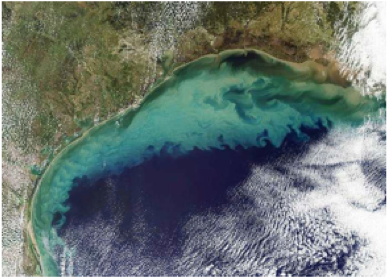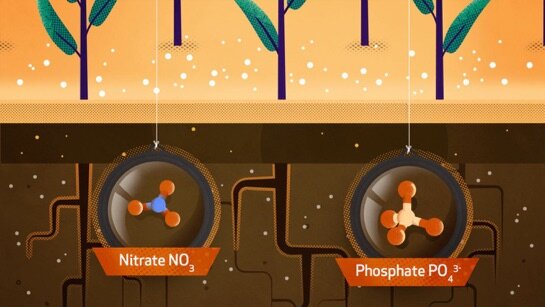


“Fertilizer contamination in the Mississippi River Basin promotes the growth of algal blooms that deplete oxygen in the water when they decompose. As a result, every summer a large hypoxic area or ‘dead zone’ forms in the Gulf of Mexico. In 2013, the dead zone covered an area of about 5,800 square miles, roughly the size of Connecticut.” - Ceres
Source: NASA Earth Observatory, September 2010; Ceres Water & Climate Risks Facing U.S. Corn Production, June 2014
Challenge
To consistently grow healthy crops, farmers add fertilizers to soil. The manufacturing and application of synthetic commercial fertilizers, however, comes with both a financial and environmental cost.
Vast quantities of fertilizer nutrients are not retained in soil. These run-off in to lakes and streams and also leach into ground water, polluting our environment and poisoning our water . The effects of nutrient pollution can been seen in many places, including the Gulf of Mexico “Dead Zone.”
A cost-effective and sustainable approach for increasing crop yields while protecting our environment is urgently needed .
Services
ASI is dedicated to providing innovative environmental services to its agricultural and wastewater management clients, including both technical consulting and soil and wastewater treatment services. With its team of dedicated scientists and engineering consultants, ASI will analyze and evaluate a client’s specific needs to develop and implement an effective and cost-efficient solution to treat soil and wastewater.
Solution
ASI’s unique approach replaces synthetic fertilizers and keeps nutrients in the root zone of plants, preventing nutrient losses and pollution. By retaining nearly 100% of the nutrients where they belong, in the root zone, ASI is able to deliver a 30%+ increase in crop yields.
ASI’s technology prevents billions of dollars in nutrients from washing away while protecting our water and making farming dramatically more productive. Additionally, replacing the synthetic fertilizer manufacturing process with ASI’s technology eliminates the equivalent of 0.35 tons of CO2 emissions per acre, per year.
How It Works
ASI’s patent-pending Nutrient Complexer Technology (NCT) uses innovative coordination chemistry to selectively retain both cations and anions .
NCT resembles a fine powder and works at the root zone through bio-chemical communication with plant roots to release the desired nutrients on-demand.
ASI’s technology offers a 21st century nutrient and fertilizer solution that is both cost-effective and sustainable.
The Gulf of Mexico “Dead Zone”

© AgriScience, Inc. 2015-2016. All Rights Reserved. Privacy Policy .